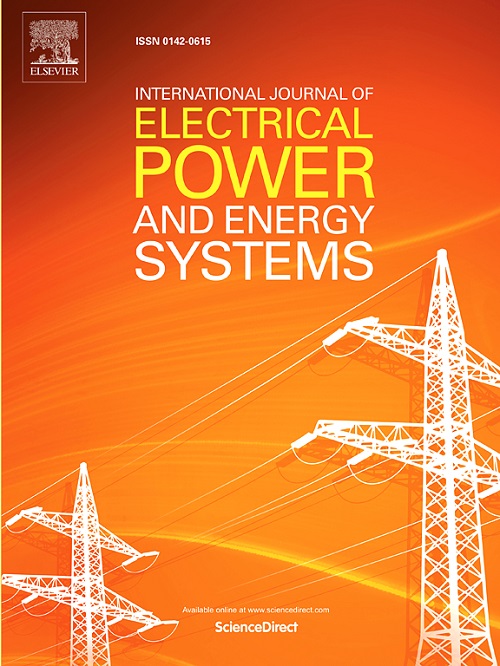Peak interval-focused wind power forecast with dynamic ramp considerations
IF 5
2区 工程技术
Q1 ENGINEERING, ELECTRICAL & ELECTRONIC
International Journal of Electrical Power & Energy Systems
Pub Date : 2024-11-04
DOI:10.1016/j.ijepes.2024.110340
引用次数: 0
Abstract
Wind power forecast (WPF) plays a crucial role in the reliable and safe operation of power systems. Existing wind power prediction methods mainly focus on the overall trend information, often neglecting the performance of some typical intervals that can significantly impact the reserve requirements of power system, e.g., unexpected ramp-up and ramp-down, local peak interval (LPI), and so on. Therefore, the primary focus of this paper is to explore techniques for enhancing the accuracy of wind power during the LPI. Considering that the points during the LPI are influenced by dynamic ramp characteristics, with the steepness and magnitude of ramps influencing the range of LPI, this paper proposes a novel focused-LPI model by incorporating dynamic ramp considerations. Specifically, beyond the tradition forecasting model, the proposed model encodes the information of ramp occurrence in wind power data based on a positional encoder; subsequently, the proposed model not only outputs standard predictions within a prediction range but also identifies the presence of ramps within these predictions. In addition, this paper employs a dynamically weighted loss function to optimize the proposed multi-task model. The proposed model is applied for various network architectures, and the results confirm that the proposed model is widely suitable for various basis network architectures. Specifically, the R-squared (R2) of the proposed model for the overall trend can exist a little error compared to the initial basic network architectures; the Mean Absolute Error (MAE), Root Mean Square Error (RMSE), and Mean Relative Error (MRE) of the proposed model for predicting the LPI points can outperform the initial basis network architecture by average enhancements of 7.10%, 2.66%, and 3.46%, respectively. In addition, compared to existing state-of-the-art (SoTA) models in the LPI points, the proposed model obtains improved performance with 14.43% for MAE and 11.19% for RMSE, respectively, presenting its substantial performance enhancement.
考虑动态斜坡因素的峰值区间重点风电预测
风功率预测(WPF)对电力系统的可靠和安全运行起着至关重要的作用。现有的风功率预测方法主要关注整体趋势信息,往往忽略了一些典型区间的表现,而这些区间会对电力系统的储备需求产生重大影响,例如意外升压和降压、局部峰值区间(LPI)等。因此,本文的主要重点是探索提高 LPI 期间风力发电精确度的技术。考虑到 LPI 期间的点受动态斜坡特性的影响,斜坡的陡度和幅度会影响 LPI 的范围,本文提出了一种新的集中 LPI 模型,将动态斜坡因素纳入考虑。具体而言,在传统预测模型之外,本文提出的模型基于位置编码器对风电数据中出现的斜坡信息进行编码;随后,本文提出的模型不仅能在预测范围内输出标准预测值,还能在这些预测值中识别斜坡的存在。此外,本文还采用了动态加权损失函数来优化所提出的多任务模型。提出的模型适用于各种网络架构,结果证实,提出的模型广泛适用于各种基础网络架构。具体地说,与初始基础网络架构相比,所提模型预测总体趋势的 R 方(R2)存在较小误差;所提模型预测 LPI 点的平均绝对误差(MAE)、均方根误差(RMSE)和平均相对误差(MRE)分别比初始基础网络架构平均提高 7.10%、2.66% 和 3.46%。此外,与 LPI 点的现有最先进(SoTA)模型相比,拟议模型的 MAE 和 RMSE 分别提高了 14.43% 和 11.19%,显示出其性能的大幅提升。
本文章由计算机程序翻译,如有差异,请以英文原文为准。
求助全文
约1分钟内获得全文
求助全文
来源期刊
CiteScore
12.10
自引率
17.30%
发文量
1022
审稿时长
51 days
期刊介绍:
The journal covers theoretical developments in electrical power and energy systems and their applications. The coverage embraces: generation and network planning; reliability; long and short term operation; expert systems; neural networks; object oriented systems; system control centres; database and information systems; stock and parameter estimation; system security and adequacy; network theory, modelling and computation; small and large system dynamics; dynamic model identification; on-line control including load and switching control; protection; distribution systems; energy economics; impact of non-conventional systems; and man-machine interfaces.
As well as original research papers, the journal publishes short contributions, book reviews and conference reports. All papers are peer-reviewed by at least two referees.

 求助内容:
求助内容: 应助结果提醒方式:
应助结果提醒方式:


